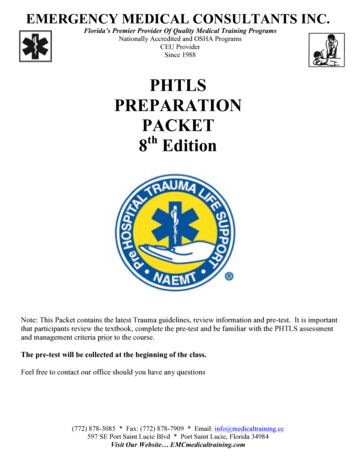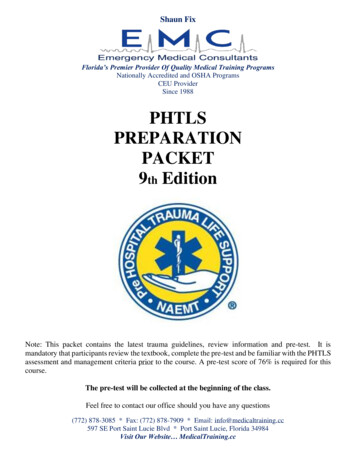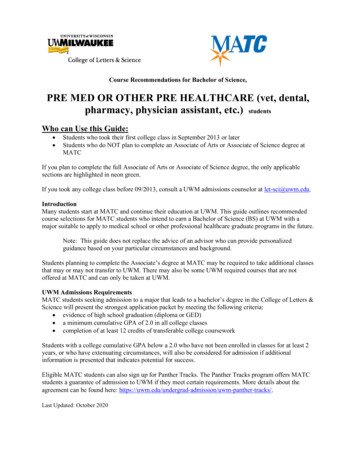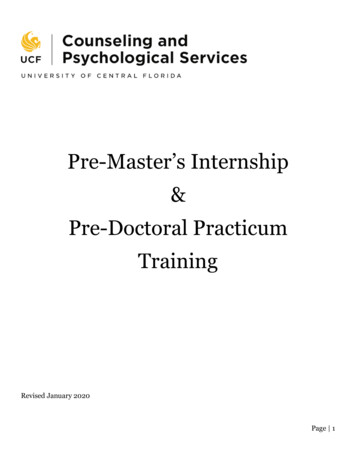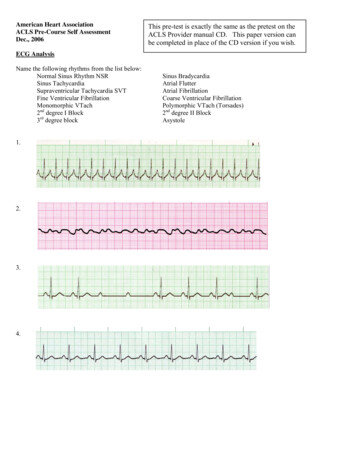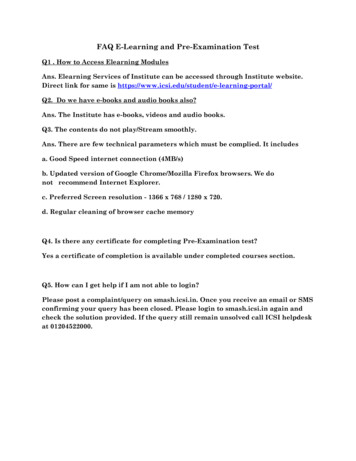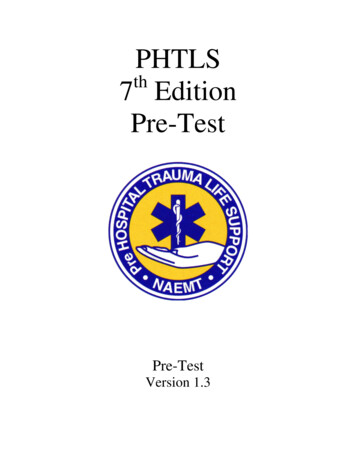
Transcription
PHTLSth7 EditionPre-TestPre-TestVersion 1.3
Instructions to CandidatesThis 25-question exam is designed to assess yourbase knowledge of trauma care. It is written for alllevels of EMTs and prehospital providers. There aresome questions that the correct answer may be anadvanced procedure that the basic-level provider isunable to perform due to system protocols or traininglevels. It is assumed that any provider who is takingthe PHTLS course, regardless of level of training,will understand and recognize the need for an ALSprocedure, even if they are not authorized to do so.To this end, the basic provider should select the ALSanswer if appropriate and not deem it incorrectbecause the procedure cannot be performed by abasic provider.Version 1.31
1)Your EMS unit is en route to the scene of an assault. Dispatch informationindicates law enforcement has not yet arrived on the scene. The safest approach tothis situation is:A) Staging at the scene so that you can advise dispatch of the nature of thepatient’s injuriesB) Arriving on scene but staying inside the vehicle until law enforcement advisesthe scene is safeC) Staging at a safe location away from the scene until law enforcement advisesthe scene is safeD) Arriving on scene and initiating care, as long as bystanders confirm theassailant is no longer there2)Which is a sign of ventilatory inadequacy in a trauma patient?A)B)C)D)3)During the primary survey of a trauma patient, you note that the patient is agitatedand confused and appears to have multiple injuries from an altercation. Of thefollowing choices, your first treatment priority should be:A)B)C)D)4)Controlling all bleedingEstablishing an intravenous lineCorrection of possible hypoxiaFull immobilization to a backboardWhich is the most common cause of upper airway obstruction in the traumapatient?A)B)C)D)5)Equal breath soundsVentilatory rate of 12Speaking in short burstsSp02 of 95% on room airTeethBloodTongueVomitusWhich is the most significant complication of prolonged suctioning of HypercarbiaVersion 1.32
6)Which is the most important reason to maintain an open airway in the traumapatient?A)B)C)D)7)Your patient is a middle-aged male who crashed his motorcycle. He isunresponsive. After opening the airway using a modified jaw thrust, you note thepatient has snoring respirations at a rate of 6. Auscultation reveals breath soundsare absent on the left side. The next intervention should be to:A)B)C)D)8)Blood lossSpinal injuryCardiac tamponadeTension pneumothoraxHypotension in the healthy adult initially occurs with what percent of blood loss?A)B)C)D)10)Insert an endotracheal tubeApply a nonrebreather maskBegin ventilation with a BVMPerform a needle decompressionHypotension of unknown etiology in a trauma patient should be assumed to resultfrom:A)B)C)D)9)To prevent snoring respirationsTo prevent aspiration and pneumoniaTo prevent hypoxemia and hypercarbiaTo prevent the tongue from blocking the pharynxLess than 15%15% to 30%31% to 40%More than 40%Medication used by trauma patients for preexisting conditions may cause whichof the following?A)B)C)D)Herbal preparations may enhance blood clotting.Anti-inflammatory agents may enhance blood clotting.Beta blockers may prevent tachycardia with blood loss.Calcium channel blockers may slow the onset of shock.Version 1.33
11)Your patient is a 20-year-old male who struck his head on a teammate’s kneewhile diving to catch a football. He was not wearing a helmet. He demonstratesdecerebrate posturing and has a GCS score of 4. His heart rate is 58, bloodpressure is 180/102, and his left pupil is dilated. What is the best ventilation rateto use when managing this patient?A)B)C)D)12)The most common cause of injury in pediatric patients less than 10 years of ageis:A)B)C)D)13.Mechanism of injuryFracture of the femurInability to communicateTenderness over the cervical spineReferencing the Parkland formula, what percent of the calculated IV volumeshould be administered in the first 8 hours following the injury?A)B)C)D)15)FallsBurnsPenetrating injuriesMotor vehicle collisionsAn 18-year-old female was struck by a car and has sustained an apparent leftfemur fracture. Communication with her is hampered because she only speaks aforeign language. Which finding, by itself, does not mandate immobilization ofthe cervical spine?A)B)C)D)14)10 breaths per minute20 breaths per minute30 breaths per minute35 breaths per minute10%25%33%50%Specific signs of inhalation injury nVersion 1.34
16)The preferred prehospital wound management for a patient with a 36% bodysurface area flame burn is:A)B)C)D)17)The most immediate life-threatening condition resulting from injury to solidabdominal organs is:A)B)C)D)18)The position of the victim when shot with the gunThe total weight of the projectile shot from the gunDistance between the victim and the gun when shotVelocity of the projectile leaving the gun when shotWhich best describes an injury caused by shearing forces?A)B)C)D)21)Height of the treeMass of the vehicleSpeed of the vehicleCircumference of the treeWhich is the most important indicator of a serious injury in a victim of a ple organ failureAcute respiratory failureYou arrive at the scene of a motor vehicle collision in which a vehicle struck atree. Which is the best indicator of potential injury?A)B)C)D)19)Elastic bandagesTopical ointmentsDry sterile dressingsCool moist dressingsLiver damage due to a gunshot woundAortic tear due to sudden decelerationBilateral leg amputation due to pedestrian/train collisionPelvic fracture due to posterior displacement of the femurBilateral femur fractures are most often associated with which type of motorcyclecrash?A)B)C)D)Rear impactAngular impactHead-on impactBike-road impactVersion 1.35
22)Severe injuries should be suspected when a patient falls from a height oftimes his or her height or greater.A)B)C)D)23)Which is the preferred adjunct device for verifying placement of an endotrachealtube in a patient with a perfusing rhythm?A)B)C)D)24)StethoscopePulse oximeterEsophageal detector deviceEnd-tidal CO2 monitoring (capnography)The target blood pressure for a trauma patient with suspected intraabdominalhemorrhage is:A)B)C)D)25)twothreefourfive60 – 70 mm Hg80 – 90 mm Hg100 – 110 mm Hg120 – 130 mm HgWhich best explains the mechanism by which gas exchange is impaired inpulmonary contusion?A)B)C)D)Blood in the alveoliCollapse of the alveoliCompression of the lung tissuePartial occlusion of the bronchiVersion 1.36
the PHTLS course, regardless of level of training, will understand and recognize the need for an ALS procedure, even if they are not authorized to do so. To this end, the basic provider should select the ALS answer if appropriate and not deem it incorrect because File Size: 225KBPage Count: 7
